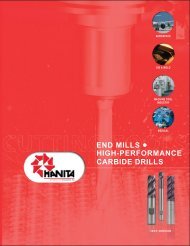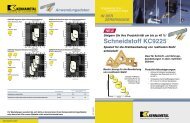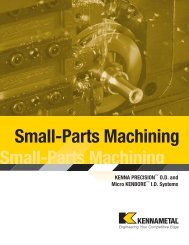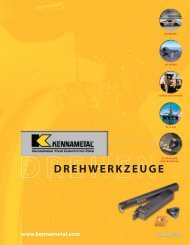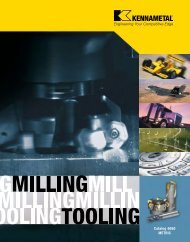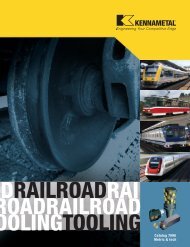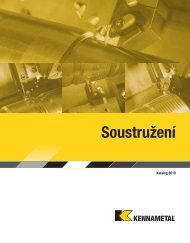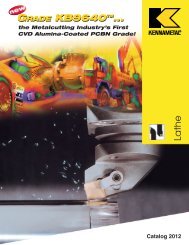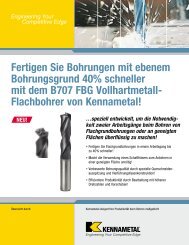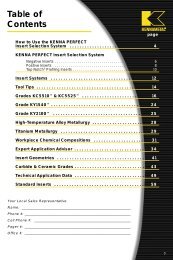- Page 1 and 2:
GTOOLINGTOOL TOOLINGSYSTE TEMSSYSTE
- Page 3 and 4:
WWW.KENNAMETAL.COM MSTOOLINGSYSTEM
- Page 5 and 6:
Kennametal is a world leader in the
- Page 7 and 8:
YSTEMSTOOLINGSYST NGSYSTEMSTOOLING
- Page 9 and 10:
WWW.KENNAMETAL.COM STOOLING LINGSYS
- Page 11 and 12:
Toolholder Selection System KM Groo
- Page 13 and 14:
Toolholder Selection System Drillin
- Page 15 and 16:
Toolholder Selection System Milling
- Page 17 and 18:
KM ® TABLE OF CONTENTS KM Overview
- Page 19 and 20:
KM Tooling System Overview The Kenn
- Page 21 and 22:
KM Cutting Units Identification Sys
- Page 23 and 24:
KM Integral Steel and Carbide Shank
- Page 25 and 26:
PRESENTING Kennametal Complete —
- Page 27 and 28:
KM Integral Steel and Carbide Shank
- Page 29 and 30:
KM Rotating Tools Identification Sy
- Page 31 and 32:
KM-LOC Clamping Units Lathe INDEX T
- Page 33 and 34:
KM-LOC Clamping Units Lathe INDEX T
- Page 35 and 36:
KM-LOC II Clamping Units Lathe HSK
- Page 37 and 38:
KM-LOC II Clamping Units Lathe STRA
- Page 39 and 40:
KM-LOC II Clamping Units Lathe INDE
- Page 41 and 42:
KM Manual Clamping Units Lathe INDE
- Page 43 and 44:
KM Manual Clamping Units Lathe KM S
- Page 45 and 46:
KM Manual Clamping Units Lathe KM S
- Page 47 and 48:
KM Manual Clamping Units Lathe L21
- Page 49 and 50:
KM Automatic Clamping Units Lathe K
- Page 51 and 52:
Introducing the tooling program as
- Page 53 and 54:
Operating Instructions for KM25 and
- Page 55 and 56:
KM25 Cutting Units Kenloc COLLETS /
- Page 57 and 58:
KM25 Cutting Units Kenloc COLLETS /
- Page 59 and 60:
KM25 Cutting Units Kenloc DV SYSTEM
- Page 61 and 62:
KM25 Cutting Units Screw-On Inserts
- Page 63 and 64:
KM25 Cutting Units Screw-On Inserts
- Page 65 and 66:
KM25 Cutting Units TOP NOTCH Thread
- Page 67 and 68:
KM25 Cutting Units A4 Groove & Turn
- Page 69 and 70:
KM25 Cutting Units A3 Cut-Off INDEX
- Page 71 and 72:
KM25 Cutting Units A2 Modular Blade
- Page 73 and 74:
KM25 Adapters Accessories INDEX TEC
- Page 75 and 76:
KM3225 Clamping Units Lathe KM SYST
- Page 77 and 78:
KM3225 Cutting Units Kenloc INDEX T
- Page 79 and 80:
KM3225 Cutting Units Kenloc STRAIGH
- Page 81 and 82:
KM3225 Cutting Units Kenloc STRAIGH
- Page 83 and 84:
KM3225 Cutting Units TOP NOTCH Groo
- Page 85 and 86:
KM3225 Cutting Units A3 Deep Groovi
- Page 87 and 88:
KM3225 Adapters BA — Boring Bar A
- Page 89 and 90:
KM32 Cutting Units Kenloc DV SYSTEM
- Page 91 and 92:
KM32 Cutting Units Kenloc COLLETS /
- Page 93 and 94:
KM32 Cutting Units P-Clamping DV SY
- Page 95 and 96:
KM32 Cutting Units Screw-On Inserts
- Page 97 and 98:
KM32 Cutting Units TOP NOTCH Profil
- Page 99 and 100:
KM32 Cutting Units TOP NOTCH Thread
- Page 101 and 102:
KM32 Cutting Units Kendex Cut-Off K
- Page 103 and 104:
KM32 Internal Cutting Units P-Clamp
- Page 105 and 106:
KM32 Internal Steel Cutting Units S
- Page 107 and 108:
KM32 Internal Steel Cutting Units T
- Page 109 and 110:
KM32 Adapters Boring Bar Adapters I
- Page 111 and 112:
KM32 Adapters Boring Bar Adapters K
- Page 113 and 114:
KM32 Collet Chucks ER — Single-An
- Page 115 and 116:
• Through-the-toolholder coolant
- Page 117 and 118:
KM32 Shank Tools Jacobs Taper Adapt
- Page 119 and 120:
ModBORE Boring Systems Rough Boring
- Page 121 and 122:
KM40 Cutting Units Kenclamp STRAIGH
- Page 123 and 124:
KM40 Cutting Units Kenclamp STRAIGH
- Page 125 and 126:
KM40 Cutting Units Kenclamp QC / R8
- Page 127 and 128:
KM40 Cutting Units Kenclamp STRAIGH
- Page 129 and 130:
KM40 Cutting Units Kenloc COLLETS /
- Page 131 and 132:
KM40 Cutting Units Kenloc COLLETS /
- Page 133 and 134:
KM40 Cutting Units Kenloc COLLETS /
- Page 135 and 136:
KM40 Cutting Units P-Clamping COLLE
- Page 137 and 138:
KM40 Cutting Units P-Clamping COLLE
- Page 139 and 140:
KM40 Cutting Units P-Clamping COLLE
- Page 141 and 142:
KM40 Cutting Units Screw-On Inserts
- Page 143 and 144:
KM40 Cutting Units Screw-On Inserts
- Page 145 and 146:
KM40 Cutting Units TOP NOTCH Profil
- Page 147 and 148:
KM40 Cutting Units Wheel Turning HS
- Page 149 and 150:
KM40 Cutting Units TOP NOTCH Thread
- Page 151 and 152:
KM40 Cutting Units A3/A4 Modular De
- Page 153 and 154:
A4 Modular Blades A4M-M — Straigh
- Page 155 and 156:
A4 Groove & Turn Modular Blades A4M
- Page 157 and 158:
A3 Deep-Grooving Modular Blades A3M
- Page 159 and 160:
KM40 Cutting Units A2 Cut-Off Block
- Page 161 and 162:
KM40 Internal Cutting Units Kenloc
- Page 163 and 164:
KM40 Internal Cutting Units Kenloc
- Page 165 and 166:
KM40 Internal Cutting Units P-Clamp
- Page 167 and 168:
KM40 Internal Steel Cutting Units S
- Page 169 and 170:
KM40 Internal Steel Cutting Units S
- Page 171 and 172:
KM40 Internal Carbide Cutting Units
- Page 173 and 174:
KM40 Internal Cutting Units TOP NOT
- Page 175 and 176:
KM40 Internal Steel Cutting Units T
- Page 177 and 178:
KM40 Internal Cutting Units LT Thre
- Page 179 and 180:
Balanced by design. Manufactured r
- Page 181 and 182:
KM40 Shank Tools ER — Single-Angl
- Page 183 and 184:
KM40 Shank Tools Drill Chucks KM SY
- Page 185 and 186:
KM40 Shank Tools SM — Shell Mill
- Page 187 and 188:
KM40 DFR DRILL-FIX Drills DFR — 2
- Page 189 and 190:
KM40 DFT DRILL-FIX Drills DFT — 2
- Page 191 and 192:
KM40 ModBORE Boring Systems Rough B
- Page 193 and 194:
KM40 Adapters STRAIGHT SHANK HSK SY
- Page 195 and 196:
KM50 Cutting Units Kenclamp STRAIGH
- Page 197 and 198:
KM50 Cutting Units Kenclamp STRAIGH
- Page 199 and 200:
KM50 Cutting Units Kenclamp QC / R8
- Page 201 and 202:
KM50 Cutting Units Kenclamp INDEX T
- Page 203 and 204:
KM50 Cutting Units Kenloc BT SYSTEM
- Page 205 and 206:
KM50 Cutting Units Kenloc BT SYSTEM
- Page 207 and 208:
KM50 Cutting Units Kenloc COLLETS /
- Page 209 and 210:
KM50 Cutting Units Kenloc INDEX TEC
- Page 211 and 212:
KM50 Cutting Units P-Clamping COLLE
- Page 213 and 214:
KM50 Cutting Units P-Clamping INDEX
- Page 215 and 216:
KM50 Cutting Units Screw-On Inserts
- Page 217 and 218:
KM50 Cutting Units Kendex TNT Ceram
- Page 219 and 220:
KM50 Cutting Units Kendex TNT Ceram
- Page 221 and 222:
KM50 Cutting Units TOP NOTCH Profil
- Page 223 and 224:
KM50 Cutting Units TOP NOTCH Thread
- Page 225 and 226:
KM50 Cutting Units A3/A4 Modular De
- Page 227 and 228:
Metalcutting Education Premier sour
- Page 229 and 230:
KM50 Internal Cutting Units Kenloc
- Page 231 and 232:
KM50 Internal Cutting Units Kenloc
- Page 233 and 234:
KM50 Internal Steel Cutting Units S
- Page 235 and 236:
KM50 Internal Carbide Cutting Units
- Page 237 and 238:
KM50 Internal Cutting Units TOP NOT
- Page 239 and 240:
KM50 Internal Cutting Units LT Thre
- Page 241 and 242:
Balanced by design. Manufactured r
- Page 243 and 244:
KM50 Shank Tools ER — Single-Angl
- Page 245 and 246:
KM50 Shank Tools Drill Chucks KM SY
- Page 247 and 248:
KM50 Shank Tools SM — Shell Mill
- Page 249 and 250:
KM50 DFR DRILL-FIX Drills DFR — 3
- Page 251 and 252:
KM50 DFT DRILL-FIX Drills DFT — 3
- Page 253 and 254:
ModBORE Boring Systems Fine Boring
- Page 255 and 256:
KM63UT Multi-Tasking INDEX TECHNICA
- Page 257 and 258:
KM63UT Cutting Units Kenclamp STRAI
- Page 259 and 260:
KM63UT Cutting Units Kenclamp STRAI
- Page 261 and 262:
KM63UT Cutting Units Kenclamp STRAI
- Page 263 and 264:
KM63UT Cutting Units Kenclamp INDEX
- Page 265 and 266:
KM63UT Cutting Units Kenloc DV SYST
- Page 267 and 268:
KM63UT Cutting Units Kenloc COLLETS
- Page 269 and 270:
KM63UT Cutting Units Kenloc COLLETS
- Page 271 and 272:
KM63UT Cutting Units P-Clamping BT
- Page 273 and 274:
KM63UT Cutting Units P-Clamping STR
- Page 275 and 276:
KM63UT Cutting Units P-Clamping BT
- Page 277 and 278:
KM63UT Cutting Units P-Clamping BT
- Page 279 and 280:
KM63UT Cutting Units P-Clamping BT
- Page 281 and 282:
KM63UT Cutting Units P-Clamping IND
- Page 283 and 284:
KM63UT Cutting Units Screw-On Inser
- Page 285 and 286:
KM63UT Cutting Units Kendex Negativ
- Page 287 and 288:
KM63UT Cutting Units TOP NOTCH Prof
- Page 289 and 290:
KM63UT Cutting Units TOP NOTCH Thre
- Page 291 and 292:
KM63UT Cutting Units On-Edge Thread
- Page 293 and 294:
KM63UT Cutting Units A2 Cut-Off Blo
- Page 295 and 296:
KM63UT Internal Cutting Units Kenlo
- Page 297 and 298:
KM63UT Internal Cutting Units P-Cla
- Page 299 and 300:
KM63UT Internal Cutting Units P-Cla
- Page 301 and 302:
KM63UT Internal Steel Cutting Units
- Page 303 and 304:
Pre-balanced G2.5 @ 15,000 rpm. Ma
- Page 305 and 306:
Slim design. Pre-balanced G6.3 @ 1
- Page 307 and 308:
• Tremendous Grip (3:1 advantage)
- Page 309 and 310:
Through-the-toolholder coolant capa
- Page 311 and 312:
KM63UT Shank Tools SM — Shell Mil
- Page 313 and 314:
ModBORE Boring Systems Rough Boring
- Page 315 and 316:
KM63UT Adapters COLLETS / SLEEVES S
- Page 317 and 318:
KM63XMZ Multi-Tasking BT SYSTEM CV
- Page 319 and 320:
KM63XMZ Multi-Tasking KM63XMZ — S
- Page 321 and 322:
KM63XMZ Mazak Multi-Tasking INDEX T
- Page 323 and 324:
KM63XMZ Cutting Units P-Clamping IN
- Page 325 and 326:
KM63XMZ Cutting Units A2 Cut-Off Bl
- Page 327 and 328:
KM63XMZ Adapters BA — Boring Bar
- Page 329 and 330:
Pre-balanced G2.5 @ 15,000 rpm. Ma
- Page 331 and 332:
Pre-balanced G2.5 @ 15,000 rpm. Ma
- Page 333 and 334:
Grip (2:1 advantage). Balanced-by-
- Page 335 and 336:
• Through-the-toolholder coolant
- Page 337 and 338:
Through-the-toolholder coolant capa
- Page 339 and 340:
KM63XMZ Shank Tools CS — Combi-Ty
- Page 341 and 342:
KM63XMZ Adapters Romicron Adapters
- Page 343 and 344:
KM80ATC Multi-Tasking KM80ATC — S
- Page 345 and 346:
KM80ATC Cutting Units Kenclamp STRA
- Page 347 and 348:
KM80ATC Cutting Units Kenloc COLLET
- Page 349 and 350:
KM80ATC Cutting Units TOP NOTCH Thr
- Page 351 and 352:
KM80ATC Shank Tools Boring Bar Adap
- Page 353 and 354:
KM80ATC Shank Tools TG — Single-A
- Page 355 and 356:
KM80ATC Adapters Straight Shank Ada
- Page 357 and 358:
KM80ATC Adapters INDEX TECHNICAL AC
- Page 359 and 360:
HSK TABLE OF CONTENTS HSK40A.......
- Page 361 and 362:
HSK Shank Tools DIN 69893 part 1, f
- Page 363 and 364:
HSK 40A Shank Tools Hydraulic Chuck
- Page 365 and 366:
Tremendous Grip (3:1 advantage). B
- Page 367 and 368:
Balanced-by-design. Through-the-to
- Page 369 and 370:
HSK 40A Shank Tools Bar Blank Mach
- Page 371 and 372:
Grip (2:1 advantage). Snap-in lock
- Page 373 and 374:
Pre-balanced G2.5 @ 15,000 rpm. Ru
- Page 375 and 376:
Slim design. Pre-balanced G2.5 @ 1
- Page 377 and 378:
Pre-balanced G6.3 @ 15,000 rpm. Ru
- Page 379 and 380:
Heavy and fine milling capabilities
- Page 381 and 382:
Grip (2:1 advantage). Snap-in lock
- Page 383 and 384:
Through-the-toolholder coolant capa
- Page 385 and 386:
Balanced-by-design. Through-the-to
- Page 387 and 388:
No through-the-toolholder coolant c
- Page 389 and 390:
HSK 63A Shank Tools HSK Modular Ada
- Page 391 and 392:
Pre-balanced G2.5 @ 15,000 rpm. Ru
- Page 393 and 394:
Grip (2:1 advantage). Snap-in lock
- Page 395 and 396:
Balanced-by-design. Through-the-to
- Page 397 and 398:
Through-the-toolholder coolant capa
- Page 399 and 400:
HSK 100A Shank Tools Shrink Fit Too
- Page 401 and 402:
Pre-balanced G2.5 @ 15,000 rpm. Ru
- Page 403 and 404:
Heavy and fine milling capabilities
- Page 405 and 406:
Grip (2:1 advantage). Snap-in lock
- Page 407 and 408:
Through-the-toolholder coolant capa
- Page 409 and 410:
Balanced-by-design. Through-the-to
- Page 411 and 412:
No through-the-toolholder coolant c
- Page 413 and 414:
For HSK adapters to DIN 69893-1 for
- Page 415 and 416:
HSK Shank Tools - form C DIN 69893
- Page 417 and 418:
Grip (2:1 advantage). Snap-in lock
- Page 419 and 420:
Pre-balanced G6.3 @ 15,000 rpm. Ru
- Page 421 and 422:
HSK 40C Shank Tools Bar Blank Mach
- Page 423 and 424:
Hydraulic Chucks — Standard Line
- Page 425 and 426:
Pre-balanced G6.3 @ 15,000 rpm. Ru
- Page 427 and 428:
Balanced-by-design. Through-the-to
- Page 429 and 430:
HSK Shank Tools - Form E DIN 69893
- Page 431 and 432:
Chucks ≤ ø 12mm (≤ ø 1/2") ar
- Page 433 and 434:
Balanced-by-design. Through-the-to
- Page 435 and 436:
HSK Shank Tools DIN 69893 part 1, f
- Page 437 and 438:
Pre-balanced G2.5 @ 15,000 rpm. Th
- Page 439 and 440:
HSK 80F (Pin) Shank Tools ER Single
- Page 441 and 442:
BT TABLE OF CONTENTS BT30..........
- Page 443 and 444:
BT Shank Tools Meets or exceeds JI
- Page 445 and 446:
Pre-balanced G6.3 @ 15,000 rpm. Ru
- Page 447 and 448:
Tremendous Grip (3:1 advantage). B
- Page 449 and 450:
Grip 1:1. Balanced-by-design. Thr
- Page 451 and 452:
Balanced-by-design. Through-the-to
- Page 453 and 454:
For KM adapters. Through-the-toolh
- Page 455 and 456:
TT-BT form B/AD — Inch (continued
- Page 457 and 458:
BT 40 Shank Tools Hydraulic Chucks
- Page 459 and 460:
Pre-balanced G6.3 @ 15,000 rpm. Ru
- Page 461 and 462:
Heavy and fine milling capabilities
- Page 463 and 464:
Grip (2:1 advantage). Pre-balanced
- Page 465 and 466:
BT 40 Shank Tools ER Single-Angle C
- Page 467 and 468:
Through-the-toolholder coolant capa
- Page 469 and 470:
Balanced-by-design. Through-the-to
- Page 471 and 472:
BT 40 Shank Tools Shell Mill Adapte
- Page 473 and 474:
No through-the-toolholder coolant c
- Page 475 and 476:
BT 40 Shank Tools Morse Taper Adapt
- Page 477 and 478:
For KM adapters. Through-the-toolh
- Page 479 and 480:
Pre-balanced G6.3 @ 15,000 rpm. Ru
- Page 481 and 482:
Slim design. Pre-balanced G6.3 @ 1
- Page 483 and 484:
Pre-balanced G6.3 @ 15,000 rpm. Ru
- Page 485 and 486:
Balanced-by-design. Runout ≤0,00
- Page 487 and 488:
Tremendous Grip (3:1 advantage). B
- Page 489 and 490:
Grip (2:1 advantage). Balanced-by-
- Page 491 and 492:
Grip 1:1. Balanced-by-design. Thr
- Page 493 and 494:
Through-the-toolholder coolant capa
- Page 495 and 496:
Balanced-by-design. Through-the-to
- Page 497 and 498:
Through-the-toolholder coolant capa
- Page 499 and 500:
Through-the-toolholder coolant capa
- Page 501 and 502:
For KM adapters. Through-the-toolh
- Page 503 and 504:
Custom Tooling Systems Solutions Wh
- Page 505 and 506:
CV TABLE OF CONTENTS CV40 - forms B
- Page 507 and 508:
CV Shank Tools Kennametal's "balan
- Page 509 and 510:
TT-CV form B/AD — Inch Cutting To
- Page 511 and 512:
HC Slim-CV form B/AD — Metric (co
- Page 513 and 514:
CV 40 Shank Tools Hydraulic Chucks
- Page 515 and 516:
CV 40 Shank Tools Milling Chucks
- Page 517 and 518:
Tremendous Grip (3:1 advantage). B
- Page 519 and 520:
CV 40 Shank Tools ER Short Single-A
- Page 521 and 522:
CV 40 Shank Tools ER Single-Angle C
- Page 523 and 524:
Balanced-by-design. 5/8" - 11 UNC
- Page 525 and 526:
Balanced-by-design. Through-the-to
- Page 527 and 528:
Balanced-by-design. 5/8" - 11 UNC
- Page 529 and 530:
CV 40 Shank Tools Tap Chucks — RC
- Page 531 and 532:
CV 40 Shank Tools KM Modular Adapte
- Page 533 and 534:
CV 50 Shank Tools Shrink Fit Toolho
- Page 535 and 536:
CV 50 Shank Tools Hydraulic Chucks
- Page 537 and 538:
Pre-balanced G6.3 @ 15,000 rpm. 1"
- Page 539 and 540:
Balanced-by-design. 1" - 8 UNC dra
- Page 541 and 542:
CV 50 Shank Tools TG Flush Face Sin
- Page 543 and 544:
Tremendous Grip (3:1 advantage) Ba
- Page 545 and 546:
CV 50 Shank Tools ER Short Single-A
- Page 547 and 548:
CV 50 Shank Tools ER Single-Angle C
- Page 549 and 550:
Balanced-by-design. 1" - 8 UNC dra
- Page 551 and 552:
Balanced-by-design. 1" - 8 UNC dra
- Page 553 and 554:
Through-the-toolholder coolant capa
- Page 555 and 556:
No through-the-toolholder coolant c
- Page 557 and 558:
CV 50 Shank Tools Morse Taper Adapt
- Page 559 and 560:
CV 50 Shank Tools KM Modular Adapte
- Page 561 and 562:
Precision Deburring • Superior Po
- Page 563 and 564:
DV TABLE OF CONTENTS DV40 - forms B
- Page 565 and 566:
DV Shank Tools Meets or exceeds DI
- Page 567 and 568:
DV 40 Shank Tools Hydraulic Chucks
- Page 569 and 570:
Pre-balanced G6.3 @ 15,000 rpm. Ru
- Page 571 and 572:
Tremendous Grip (3:1 advantage). Ba
- Page 573 and 574:
Grip (2:1 advantage). Through-the-
- Page 575 and 576:
Grip 1:1. Balanced-by-design. Thr
- Page 577 and 578:
• Through-the-toolholder coolant
- Page 579 and 580:
Through-the-toolholder coolant capa
- Page 581 and 582:
Through-the-toolholder coolant capa
- Page 583 and 584:
For KM adapters. Through-the-toolh
- Page 585 and 586:
Pre-balanced G6.3 @ 15,000 rpm. Ru
- Page 587 and 588:
DV 50 Shank Tools Hydraulic Chucks
- Page 589 and 590:
Balanced-by-design. Runout ≤0,00
- Page 591 and 592:
Tremendous Grip (3:1 advantage). B
- Page 593 and 594:
DV 50 Shank Tools ER Single-Angle C
- Page 595 and 596:
Grip 1:1. Balanced-by-design. Thr
- Page 597 and 598:
Through-the-toolholder coolant capa
- Page 599 and 600:
Through-the-toolholder coolant capa
- Page 601 and 602:
Rapid-change style. Tension and co
- Page 603 and 604:
For KM adapters. Through-the-toolh
- Page 605 and 606:
QC-R8 TABLE OF CONTENTS QC30.......
- Page 607 and 608:
Quick-change (QC) shank design is s
- Page 609 and 610:
Grip (1:1). Balanced-by-design. 1
- Page 611 and 612:
Tremendous Grip (3:1 advantage). B
- Page 613 and 614:
Balanced-by-design. 5/8" - 11 UNC
- Page 615 and 616:
Tremendous Grip (3:1 advantage). B
- Page 617 and 618:
No through-the-toolholder coolant c
- Page 619 and 620:
R8 Shank Tools Introduction KM SYST
- Page 621 and 622:
R8 Shank Tools Shell Mill Adapters
- Page 623 and 624:
Straight Shank TABLE OF CONTENTS Sh
- Page 625 and 626:
Straight-shank toolholder extension
- Page 627 and 628:
Tremendous Grip (3:1 advantage). A
- Page 629 and 630:
Grip (2:1 advantage). Balanced-by-
- Page 631 and 632:
General Engineering Kennametal enab
- Page 633 and 634:
Spare Parts (continued from previou
- Page 635 and 636:
DA-Style 04-SS — Inch Straight Sh
- Page 637 and 638:
Spare Parts (continued from previou
- Page 639 and 640:
Grip 1:1. Industry-standard Ericks
- Page 641 and 642:
Grip 1:1. Industry-standard Ericks
- Page 643 and 644:
Collets and Sleeves TABLE OF CONTEN
- Page 645 and 646:
HC - Hydraulic chuck sleeves Drilli
- Page 647 and 648:
Collets and Sleeves 20mm HC Hydraul
- Page 649 and 650:
One-piece design with slot configur
- Page 651 and 652:
One-piece design with slot configur
- Page 653 and 654:
One-piece design. Cutting tool mus
- Page 655 and 656:
Collets and Sleeves 3/4" SMC Millin
- Page 657 and 658:
Collets and Sleeves 1 1/4" SMC Mill
- Page 659 and 660:
Provides "Tremendous Grip" (3:1 adv
- Page 661 and 662:
TG50 Collet — Inch (continued fro
- Page 663 and 664:
Twice as accurate as the standard T
- Page 665 and 666:
Collets and Sleeves TG50 Single Ang
- Page 667 and 668:
Provides "Tremendous Grip" (3:1 adv
- Page 669 and 670:
An economical way to purchase a gro
- Page 671 and 672:
Twice as accurate as the standard T
- Page 673 and 674:
Provides "Tremendous Grip" (3:1 adv
- Page 675 and 676:
Collets and Sleeves TG75 Single Ang
- Page 677 and 678:
TG100 Collet — Inch (continued on
- Page 679 and 680:
Rubber-filled slots seal collet for
- Page 681 and 682:
Twice as accurate as the standard T
- Page 683 and 684:
Provides "Tremendous Grip" (3:1 adv
- Page 685 and 686:
Collets and Sleeves TG100 Single An
- Page 687 and 688:
TG150 Collet — Inch (continued fr
- Page 689 and 690:
An economical way to purchase a gro
- Page 691 and 692:
Automotive Kennametal enables leadi
- Page 693 and 694:
Provides approximately 2:1 grip adv
- Page 695 and 696:
Provides approximately 2:1 grip adv
- Page 697 and 698:
Collets and Sleeves ER16 Single Ang
- Page 699 and 700:
Collets and Sleeves ER20 Single Ang
- Page 701 and 702:
Collets and Sleeves ER25 Single Ang
- Page 703 and 704:
Collets and Sleeves ER25 Single Ang
- Page 705 and 706:
Collets and Sleeves ER32 Single Ang
- Page 707 and 708:
Collets and Sleeves ER32 Single Ang
- Page 709 and 710:
ER40 Collet — Inch (continued fro
- Page 711 and 712:
Collets and Sleeves ER40 Single Ang
- Page 713 and 714:
Supply-Chain Services We deliver th
- Page 715 and 716:
DA - Double Angle Collets Drilling
- Page 717 and 718:
Provides 1:1 grip for most drilling
- Page 719 and 720:
Provides 1:1 grip for most drilling
- Page 721 and 722:
Rubber-filled slots seal collet for
- Page 723 and 724:
DA100 Collet — Inch (continued fr
- Page 725 and 726:
Rubber-filled slots seal collet for
- Page 727 and 728:
DA180 Collet — Inch (continued fr
- Page 729 and 730:
Rubber-filled slots seal collet for
- Page 731 and 732: Collets and Sleeves DA-J Series Dou
- Page 733 and 734: Collets and Sleeves DA-L Series Dou
- Page 735 and 736: Rapid-change style. Solid positive
- Page 737 and 738: Rapid-change style. Solid positive
- Page 739 and 740: Rapid-change style. Solid positive
- Page 741 and 742: Accessories TABLE OF CONTENTS Balan
- Page 743 and 744: Shrink Fit — Induction Coil Shrin
- Page 745 and 746: Accessories Shrink Fit — Axial Ad
- Page 747 and 748: Accessories Collet Extractor — TG
- Page 749 and 750: Balanceable and interchangeable loc
- Page 751 and 752: Standard and replaceable locknuts a
- Page 753 and 754: 0,5mm (.020") range of sealing per
- Page 755 and 756: 0,5mm (.020") range of sealing per
- Page 757 and 758: Accessories ER40 Coolant Locknut Se
- Page 759 and 760: Stop screw caps can easily be snapp
- Page 761 and 762: Universal vise to hold HSK forms A,
- Page 763 and 764: For acceptance testing on machine t
- Page 765 and 766: Accessories Spindle Wiper — 7/24
- Page 767 and 768: Metric thread. Piloted. Through-c
- Page 769 and 770: Metric thread. No pilot. Through-
- Page 771 and 772: Accessories Torque Wrench — KM Ma
- Page 773 and 774: Accessories Wrench — Pin Spanner
- Page 775 and 776: Technical Data TABLE OF CONTENTS KM
- Page 777 and 778: Manual Clamping System Characterist
- Page 779 and 780: Technical Information KM Tooling KM
- Page 781: Assembly/Disassembly Instructions A
- Page 785 and 786: KM63XMZ Tool Orientation Specificat
- Page 787 and 788: The KM tooling joint is an extremel
- Page 789 and 790: Chart 3 0.45 0.4 0.35 0.3 0.25 doc
- Page 791 and 792: KM63 Technical Information KM Tooli
- Page 793 and 794: VDI Application Guide Technical Inf
- Page 795 and 796: KM LOC-II CL2NS/T-EF Flanges KM Ma
- Page 797 and 798: • KM LOC-II CL2NS/T-BC Technical
- Page 799 and 800: KM RACA and NACA Spring Pack Cylind
- Page 801 and 802: VDMA Technical Technical Informatio
- Page 803 and 804: Common general dimensions to help y
- Page 805 and 806: Balancing Kennametal offers a range
- Page 807 and 808: Technical Information Hydraulic Chu
- Page 809 and 810: Technical Information Hydraulic Chu
- Page 811 and 812: Technical Information Shrink Fit KM
- Page 813 and 814: Toolholders • Slim design • Bal
- Page 815 and 816: Technical Information HPMC Milling
- Page 817 and 818: Automotive Kennametal enables leadi
- Page 819 and 820: Technical Information Collet Series
- Page 821 and 822: Technical Information Collets .001"
- Page 823 and 824: 1. KM Lockscrew 2. Adjustment Locks
- Page 825 and 826: Index By Order Number Order No Cata
- Page 827 and 828: Index By Order Number Order No Cata
- Page 829 and 830: Index By Order Number Order No Cata
- Page 831 and 832: Index By Order Number Order No Cata
- Page 833 and 834:
Index By Order Number Order No Cata
- Page 835 and 836:
Index By Order Number Order No Cata
- Page 837 and 838:
Index By Order Number Order No Cata
- Page 839 and 840:
Index By Order Number Order No Cata
- Page 841 and 842:
Index By Order Number Order No Cata
- Page 843 and 844:
Metalcutting Safety Metalcutting Sa



